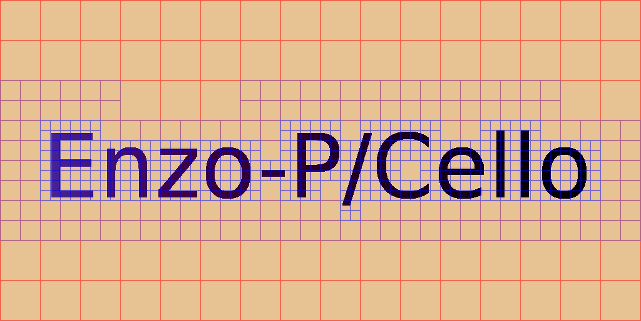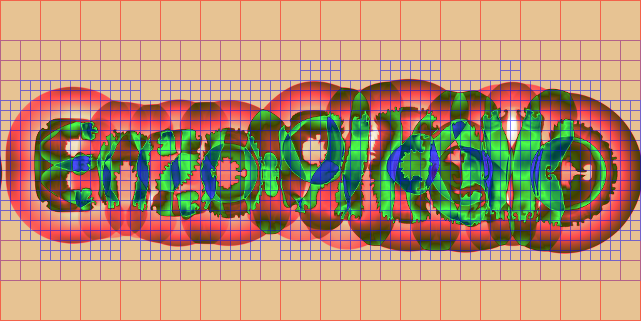Enzo-E / Cello Guiding Principles
Key guiding principles in Enzo-E / Cello design and construction are performance, scalability, usability, reliability, and flexibility.
Performance
Cello enables high single-node performance through the design of its data classes for fields (Eularian) and particles (Lagrangian)
The Field class represents arrays of field variables (density, velocity, etc.) that are associated with blocks of the AMR hierarchy. The size of these block-local arrays is specified by the user in Enzo’s configuration file, allowing flexibility for optimizing for cache size and parallel task granularity. Cello’s field data also supports improving performance through data alignment and data structure padding. Data alignment—aligning array elements along 128-bit boundaries—can greatly improve performance of a CPU’s SIMD instructions. Data structure padding—separating field arrays by some small multiple of the cache line length—can reduce cache conflict and improve cache reuse. Block size, data alignment, and data structure padding are all controllable through Enzo-E’s parameter file.
The Particle class represents particles associated with blocks in the AMR hierarchy. It can represent multiple particle types, with particles in each type having arbitrary attributes (though a minimal particle type must have a position). For efficiency, particles are allocated and operated on a batch at a time, where the number of particles in each batch is specified by the user. Particles within a batch can be stored in two different ways: by particle, or by attribute, which again can affect efficiency. Additionally, storing particles in fixed-sized batches should aid in the implementation of efficient accelerator-based code (CUDA, OpenACC, etc.) for particles.
Scalability
Cello enables high scalability in part through the innovative combination of Charm++ and Cello’s array-of-octree AMR. Charm++, the externally-developed parallel programming system on which Cello is built, is a data-driven, asynchronous, programming language based on C++. Charm++ incorporates state-of-the-art dynamic load balancing, its asynchronous execution model is naturally latency-tolerant, and it provides automatic overlap of computation and communication. Emergent scalability issues such as fault-tolerance and energy efficiency are also being researched and incorporated into Charm++, allowing Enzo-E / Cello to benefit automatically as the parallel programming system continues to improve.
The array-of-octree AMR approach that is implemented in Cello has been shown to be among the most scalable known AMR approaches to date. The specific AMR remeshing algorithm is based on that developed and prototyped by the Charm++ group (see Langer, et al). As in their approach, our mesh refinement algorithm proceeds mostly asynchronously, using only a lightweight barrier-like operation provided by the Charm++ runtime system to detect consensus on refinement levels between blocks.
Usability
Cello is designed to be both user-friendly and developer-friendly. The integrated Enzo-E / Cello structured configuration files are easy to read and write, and allow for much more powerful yet easy-to-understand problem initialization than in Enzo. As an example, the simple test problem whose output is shown above used the combination of a PNG image file created using a paint program, together with the following configuration to initialize the density field:
Initial {
density { value = [ 1.0 + x, "input/density_mask.png", 0.125 ]; }
}
This reads naturally as “initialize density with the value 1.0 wherever the input image mask is set (i.e. not black), and 0.125 elsewhere.”
Logical expressions such as x + sin(y) < 0.5 can be used in
place of image masks, and multiple masks and logical expressions can
be combined to generate arbitrarily complex initial conditions. This
capability greatly simplifies the user experience of setting up a test
problem, making Enzo-E not only useful for researchers to run
scientifically viable simulations, but also for students and educators
to learn and experiment with concepts in computational fluid dynamics
and astrophysics.
Migrating new functionality from Enzo or other science applications to Enzo-E / Cello is also very developer-friendly. Only the serial code implementing a numerical method on a single grid patch in Enzo is required, and frequently no modifications of the method code are even necessary. The bulk of the migration effort required is writing an EnzoBlock class that contains static variables to replace Enzo’s global variables, but this has already been done. Even Enzo’s troublesome redefinition of float to double can be easily handled, by globally replacing float with the macro enzo_float in the code being migrated.
Reliability
Cello currently contains a large and growing collection of test problems, together with built-in support for both running tests and visualizing results. The running of tests is incorporated into the software build system and invoked by executing the provided ./regression.sh script, and test results are visualized through a supplied PHP hypertext preprocessor web page. Cello also has support for testing invariants during code execution, helping to identify numerical anomalies and reporting them to the user before they may otherwise make themselves known, which reduces time debugging and leads to overall higher software quality. Defect tracking is coordinated through Bugzilla to ensure that users have a means to report bugs, and that developers have the means to obtain the information required to fix them.
Flexibility
We anticipate new and possibly disruptive developments in hardware, as well as new developments in numerical methods and parallel data structures, so flexibility is a high priority in our design and development. Object-oriented programming provides a natural flexibility through polymorphism, encapsulation, and separation of interface and implementation. Also, we have adopted an agile iterative test-driven development approach with continuous refactoring, which improves flexibility by reducing code complexity and improving code readability.

